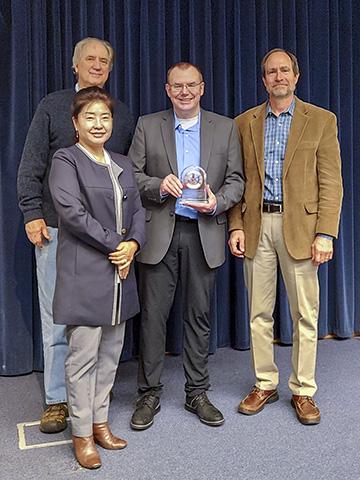The 2023 David Derse Memorial Lecture and Award coincided with Día de los Muertos, scientist emeritus Stephen Hughes, Ph.D., noted at the event. It was fitting happenstance.
The Day of the Dead, as it’s called in English, is observed primarily in Mexico to celebrate the memory and legacy of deceased loved ones. The living gather to spend time with each other and pay tribute to the dead. In a similar spirit, the memorial lecture in Frederick united scientists to enjoy each other’s company and—for the 12th straight year—honor the legacy of David Derse, Ph.D., a beloved NCI Frederick retrovirologist who passed away in 2009.
“We want to remember him not only as a scientist but someone whom we valued as a person,” Hughes said of his former colleague.
Louis Mansky, Ph.D., a professor and the director of the Institute of Molecular Virology at the University of Minnesota, came to NCI Frederick to deliver the lecture. Every year since 2012, NCI’s HIV Dynamics and Replication Program (HIV DRP) has invited a respected scientist to the lectern in honor of Derse.
Mansky’s lecture, an overview of his lab’s work to compare HIV-1 and human T-lymphotropic virus 1 (HTLV-1), was itself a fitting homage to the late virologist. Derse was an expert in HTLV and HIV. His team even discovered how HTLV-1 evades the human immune system, an insightful and important finding for immunology.
Mansky acknowledged Derse’s stature. Included among his slides of viral proteins and fluorescence analyses were images of letters he exchanged with Derse—all dated from the start of Mansky’s career. He warmly noted Derse’s geniality and willingness to cooperate with young scientists in those days.
The lecture proved to be scientifically stimulating, as well. Mansky guided the audience through data from intricate analyses of the Gag protein and viral membrane in HTLV-1 and HIV-1. The topic evoked such curiosity that some enthusiastic listeners spoke up mid-presentation to ask questions.
The HIV DRP, in partnership with Hye Kyung Chung-Derse, Ph.D., Derse’s widow—and with support from NCI—subsequently conferred the David Derse Memorial Award on Mansky in recognition of his outstanding contributions to research on HIV and cancer-associated viral diseases.
Afterward, participants gathered for an informal networking session over cake provided by Chung-Derse.
Ties to the Past, Ties to Each Other
Eric Freed, Ph.D., HIV DRP director, remarked that connections at the event ran deep among disciplines and people alike. Mansky has a long history of interacting with researchers at NCI Frederick. He and Freed, like several others in Frederick, are also alumni of the McArdle Laboratory for Cancer Research at the University of Wisconsin, Madison.
“Many people in the field know his name, even if they haven’t worked for him,” Freed said of Mansky.
The collegial air from these connections was unmistakable, especially among the HIV DRP’s veteran staff. Scientists greeted each other as old friends. Many have worked together against AIDS, cancer, and cancer-causing viruses for decades. It was a celebration of Derse’s life and the participants’ shared story as much as it was a lecture—a time to look back upon a collective history with deep roots in Frederick.
After all, Frederick is where Matthew Gonda, Ph.D., and team obtained some of the first microscopic images of HIV in the early 1980s. It’s where the Biological Products Laboratory, then led by Larry Arthur, Ph.D., produced large amounts of viral material for the first blood tests for HIV antibody, which directly enabled Abbott Laboratories’ groundbreaking test in 1985 that made it possible to screen the national blood supply for HIV.
Frederick is where Barbara Felber, Ph.D., and George Pavlakis, Ph.D., developed an assay to measure the amount of HIV in cells. It’s where still others supported the AIDS Task Force during the uncertain early years of the epidemic. It’s where Hughes and collaborators showed in 2021 that HIV can, in some cases, directly drive cancer.
It’s where scientists like Derse made their mark on science—and where many in the HIV DRP, AIDS and Cancer Virus Program, and others are still making theirs.
It was a perfect place for researchers to take a few hours to recognize important science, consider the contributions of scientists past and present, and honor the memory of a respected virologist and former colleague. The David Derse Memorial Lecture and Award did all these things, a reminder that past and future are ever connected.
“It’s so important to acknowledge our colleagues,” Mansky said, perhaps best summing up the spirit of the event. “It’s so important for the younger people to know who the people were who shaped our lives.”
Samuel Lopez leads the editorial team in Scientific Publications, Graphics & Media (SPGM). He writes for newsletters; informally serves as an institutional historian; and edits scientific manuscripts, corporate documents, and sundry other written media. SPGM is the creative services department and hub for editing, illustration, graphic design, formatting, multimedia, and training in these areas.








